AUDI S7 2016 Owners Manual
Manufacturer: AUDI, Model Year: 2016, Model line: S7, Model: AUDI S7 2016Pages: 294, PDF Size: 73.82 MB
Page 131 of 294
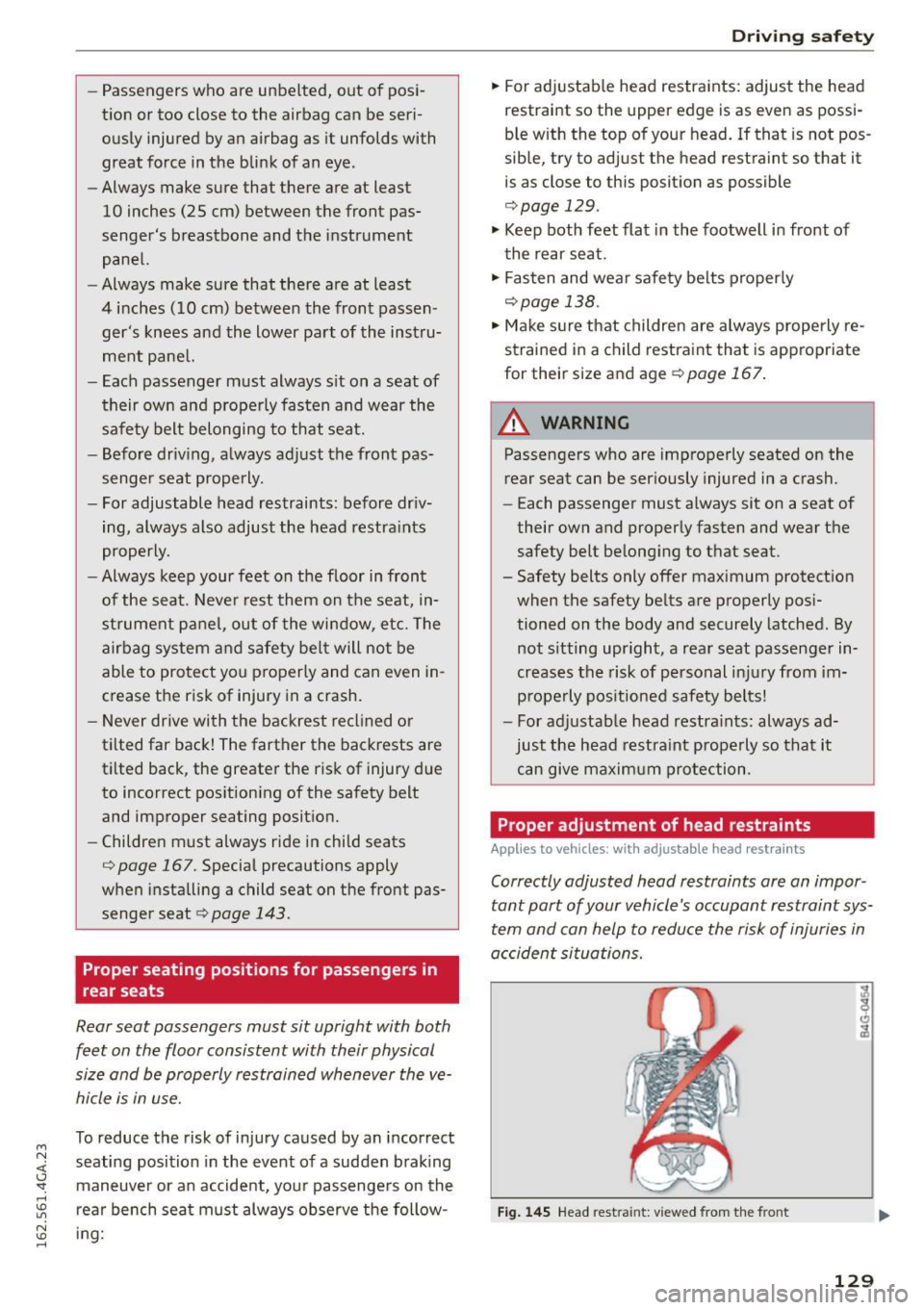
M N <( I.J "". rl I.O
"'
-Passengers who are unbelted, out of posi
tion or too dose to the airbag can be seri
ously injured by an airbag as it unfolds with great force in the blink of an eye.
- Always make sure that there are at least
10 inches (25 cm) between the front pas
senger's breastbone and the instrument panel.
- Always make sure that there are at least
4 inches (10 cm) between the front passen
ger's knees and the lower part of the instru
ment panel.
- Each passenger must always sit on a seat of
their own and properly fasten and wear the safety belt belonging to that seat.
- Before driving, always adjust the front pas
senger seat properly.
- For adjustable head restraints: before driv
ing, always also adjust the head restraints
properly.
- Always keep your feet on the floor in front
of the seat. Never rest them on the seat, in
strument panel, out of the window, etc. The
airbag system and safety belt will not be
able to protect you properly and can even in
crease the risk of injury in a crash.
- Never drive with the backrest reclined or
tilted far back! The farther the backrests are
tilted back, the greater the risk of injury due
to incorrect positioning of the safety belt and improper seating position.
- Children must always ride in child seats
c> page 167. Special precautions apply
when installing a child seat on the front pas senger seat
c> page 143.
Proper seating positions for passengers in
rear seats
Rear seat passengers must sit upright with both
feet on the floor consistent with their physical
size and be properly restrained whenever the ve
hicle is in use.
To reduce the risk of injury caused by an incorrect
seating position in the event of a sudden braking
maneuver or an accident, your passengers on the
rear bench seat must always observe the follow-
~ 1ng: rl
Driving safety
.,. For adjustable head restraints : adjust the head
restraint so the upper edge is as even as possi
ble with the top of your head. If that is not pos
sible, try to adjust the head restraint so that it
is as close to this position as possible
c>page 129 .
.,. Keep both feet flat in the footwell in front of
the rear seat.
.,. Fasten and wear safety belts properly
c> page 138.
.,. Make sure that children are always properly re
strained in a child restraint that is appropriate
for their size and age
c> page 167.
A WARNING
-
Passengers who are improperly seated on the
rear seat can be seriously injured in a crash.
- Each passenger must always sit on a seat of
their own and properly fasten and wear the
safety belt belonging to that seat .
- Safety belts only offer maximum protection when the safety belts are properly posi
tioned on the body and securely latched. By not sitting upright, a rear seat passenger in
creases the risk of personal injury from im
properly positioned safety belts!
- For adjustable head restraints: always ad
just the head restraint properly so that it
can give maximum protection .
Proper adjustment of head restraints
Applies to vehicles: with adjustable head restraints
Correctly adjusted head restraints are an impor
tant part of your vehicle's occupant restraint sys
tem and can help to reduce the risk of injuries in
accident situations.
Fig. 145 Head restra int: v iewed from the front
129
Page 132 of 294

Driving safety
The head restraints must be correctly adjusted to
achieve the best protection.
.,. Adjust the head restraint so the upper edge is
as even as possible with the top of your head.
If
that is not possible, try to adjust the head re
straint so that it is as close to this position as
possible
c:::> fig. 145. Move the head restraint so
that it is as close to the back of the head as
possible.
.,. If there is a passenger on the rear center seat
ing position*, slide the center head restraint*
upward at least to the next notch.
Adjusting head restraints
c:::> page 55.
A WARNING
All seats are equipped with head restraints. Driving without head restraints or with head
restraints that are not properly adjusted in
creases the risk of serious or fatal neck injury
dramatically. To help reduce the risk of injury:
- Always drive with the head restraints in
place and properly adjusted.
- Every person in the vehicle must have a
properly adjusted head restraint.
-Always make sure each person in the vehicle
properly adjusts their head restraint. Adjust
the head restraint so the upper edge is as
even as possible with the top of your head.
If that is not possible, try to adjust the head
restraint so that it is as close to this position
as possible. Move the head restraint so that
it is as close to the back of the head as pos
sible.
- Never attempt to adjust head restraint while driving. If you have driven off and
must adjust the driver headrest for any rea
son, first stop the vehicle safely before at
tempting to adjust the head restraint.
- Children must always be properly restrained in a child restraint that is appropriate for
their age and size
c:::> page 167 .
130
-
Examples of improper seating positions
The occupant restraint system can only reduce
the risk of injury if vehicle occupants are properly
seated .
Improper seating positions can cause serious in
jury or death. Safety belts can only work when they are properly positioned on the body . Im
proper seating positions reduce the effectiveness
of safety belts and will even increase the risk of injury and death by moving the safety belt to crit
ical areas of the body. Improper seating positions
also increase the risk of serious injury and death
when an airbag deploys and strikes an occupant
who is not in the proper seating position. A driver
is responsible for the safety of all vehicle occu
pants and especially for children. Therefore:
.,. Never allow anyone to assume an incorrect
seating position when the vehicle is being used
c:::> A .
The following bulletins list only some sample po
sitions that will increase the risk of serious injury
and death . Our hope is that these examples will
make you more aware of seating positions that
are dangerous.
Therefore, whenever the vehicle is moving:
-never stand up in the vehicle
- never stand on the seats
- never kneel on the seats
- never ride with the seatback reclined
- never lie down on the rear seat
- never lean up against the instrument panel
- never sit on the edge of the seat
- never sit sideways
- never lean out the window
- never put your feet out the window
- never put your feet on the instrument panel
- never rest your feet on the seat cushion or back
of the seat
- never ride in the footwell
- never ride in the cargo area
Page 133 of 294

A WARNING ,~
Improper seating positions increase the risk
of serious personal injury and death whenever
a vehicle is be ing used.
- Always make sure that all vehicle occupants
stay in a proper seating position and are
properly restrained whenever the vehicle is
being used.
Driver's and front
passenger's footwell
Important safety instructions
Applies to vehicles: with knee airbags
A WARNING
Always make sure that the knee a irbag can in
flate without interference . Objects between
yourself and the airbag can increase the risk of injury in an accident by interfering with the
way the airbag deploys or by being pushed in
to you as the airbag deploys.
- No persons (chi ldren) or animals should ride
in the footwell in front of the passenger
seat. If the airbag deploys, this can result in
serious or fatal injuries.
- No objects of any k ind shou ld be carried in
the footwe ll area in front of the dr iver's or
passenger's seat. Bulky objects (shopp ing
bags, for example) can hamper or p revent
proper deployment of the airbag . Small ob
jects can be thrown thro ugh the vehi cle if
the a irbag deploys and injure you or you r
passenge rs .
Pedal area
Pedals
The pedals must always be free to move and
must never be interfered with by a floor mat or
any other object.
Make sure that all pedals move freely witho ut in-
~ terference and that noth ing prevents them from
j returning to their original pos it ions .
'SI:
~ Only use floor mats that leave the peda l area free 1.1'1
~ and can be secured with floor mat fasteners . ......
Drivin g s afet y
If a brake circuit fai ls, increased brake pedal trav
el is required to bring the vehicle to a full stop.
A WARNING
-Pedals that cannot move free ly can cause loss
of vehicle control and increase the risk of ser i
ous injury.
- Never p lace any objects in the driver's foot
well. An object could get into the pedal area
and interfere with pedal function. In case of
sudden braking or an accident, you would
not be able to b rake or accelerate!
- Always make sure that nothing can fall or
move into the d river's footwell.
Floor mats on the driver side
Always use floor mats that can be securely at
tached to the floor mat fasteners and do not in
terfere with the free movement of the pedals .
.. Make sure that the floor mats are properly se-
cured and cannot move and interfere with the
pedals¢ .&,.
Use only floor mats that leave the peda l area un
obstructed and that are firmly secured so that
they cannot slip out of position . You can obtain
su itable floor mats from your authorized Aud i
Dealer .
Floor mat fasteners are insta lled in your Audi.
Floor mats used in yo ur vehicle must be attached
to these fasteners. Properly sec uring the floor
mats will prevent them from s liding into posi
t ions that could interfere with the pedals or im
pair safe operation of your vehicle in other ways .
A WARNING ~
Pedals that cannot move freely can result in a
l oss of vehicle control and increase the risk of
se rious pe rsonal injury.
- Always ma ke sure that floor mats a re prop
erly secured .
- Never p lace or install floor mats or other
f loor cove rings in the vehicle that cannot be
properly secu red in p lace to prevent them
from slipp ing and in terfering wi th the ped-
als o r the ab ility to cont rol the vehicle.
~
1 3 1
Page 134 of 294
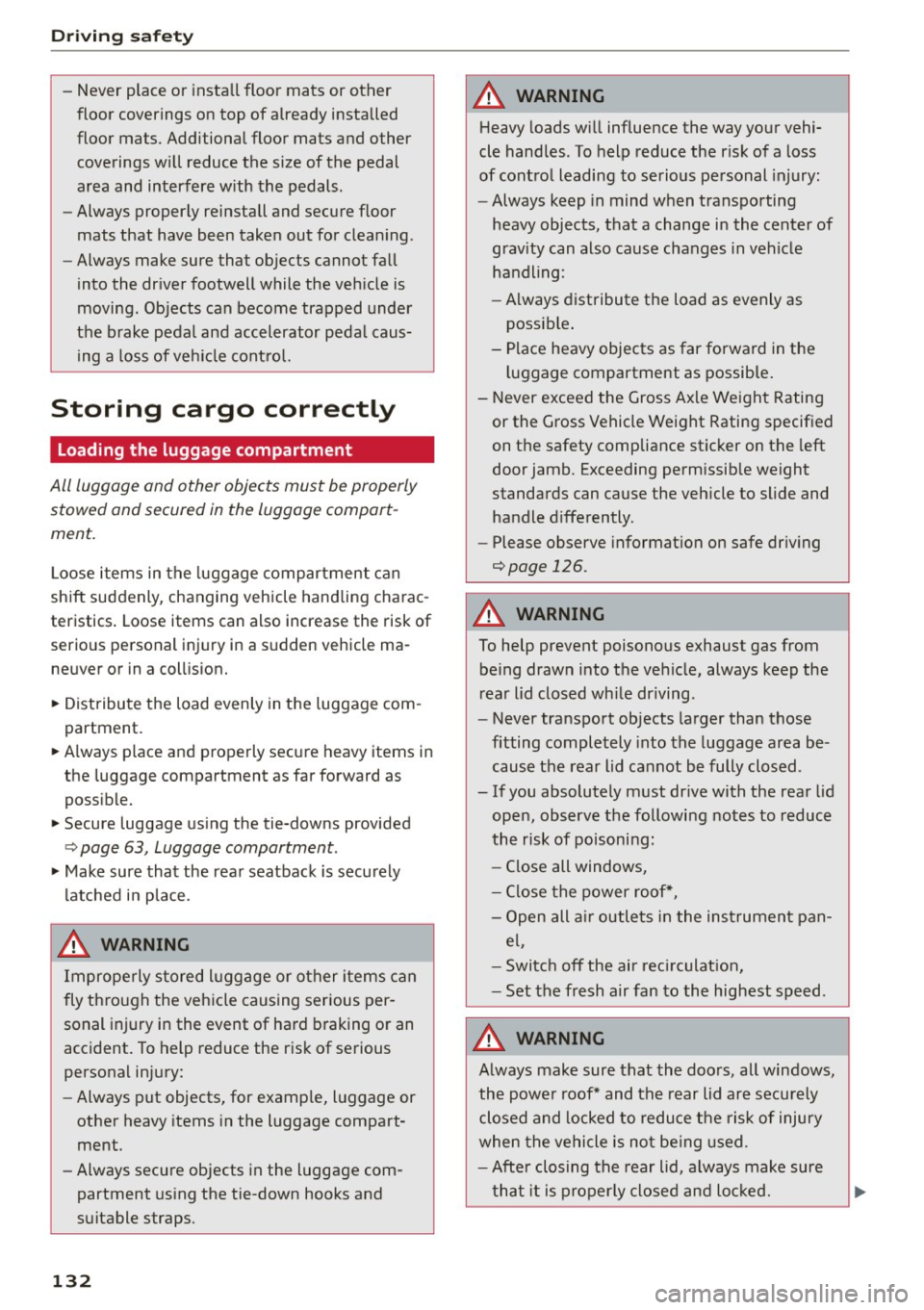
Driving safety
-Never place or install floor mats or other
floor coverings on top of already installed
floor mats. Additional floor mats and other coverings will reduce the size of the pedal
area and interfere with the pedals .
- Always properly reinstall and secure floor
mats that have been taken out for cleaning .
- Always make sure that objects cannot fall
into the driver footwell while the vehicle is
moving . Objects can become trapped under
the brake pedal and accelerator pedal caus ing a loss of veh icle control.
Storing cargo correctly
Loading the luggage compartment
All luggage and other objects must be properly
stowed and secured in the luggage compart
ment.
Loose items in the luggage compartment can
shift suddenly, changing vehicle handling charac
teristics. Loose items can also increase the risk of
serious personal injury in a sudden vehicle ma
neuver or in a collision.
.. Distribute the load evenly in the luggage com
partment.
.. Always place and properly secure heavy items in
the luggage compartment as far forward as
possible.
.. Secure luggage using the tie-downs provided
¢ page 63, Luggage compartment.
.,. Make sure that the rear seatback is securely
latched in place .
_& WARNING
Improperly stored luggage or other items can
fly through the vehicle causing serious per
sonal injury in the event of hard braking or an
accident. To help reduce the risk of serious
personal injury:
- Always put objects, for example, luggage or
other heavy items in the luggage compart
ment.
- Always secure objects in the luggage com
partment using the tie-down hooks and
suitable straps.
132
_& WARNING ~ -
Heavy loads will influence the way your vehi
cle handles. To help reduce the r isk of a loss
of control leading to serious personal injury:
- Always keep in mind when transporting
heavy objects, that a change in the center of
gravity can also cause changes in vehicle
handling:
- Always distribute the load as evenly as
possible .
- Place heavy objects as far forward in the luggage compartment as possible.
- Never exceed the Gross Axle Weight Rating
or the Gross Vehicle Weight Rating specified
on the safety compliance sticker on the left
door jamb. Exceeding permissible weight
standards can cause the vehicle to slide and
handle differently .
- Please observe information on safe driving
¢page 126.
_& WARNING
To help prevent poisonous exhaust gas from
being drawn into the vehicle, always keep the
rear lid closed wh ile driving .
- Never transport objects larger than those
fitting completely into the luggage area be
cause the rear lid cannot be fully closed .
- If you absolutely must drive with the rear lid open, observe the following notes to reduce
the risk of poisoning:
- Close all windows,
- Close the power roof*,
- Open all a ir outlets in the instrument pan-
el,
- Switch off the air rec irculat ion,
- Set the fresh air fan to the highest speed.
_& WARNING
Always make sure that the doors, all windows,
the power roof* and the rear lid are securely
closed and locked to reduce the risk of injury
when the vehicle is not be ing used.
- After closing the rear lid, always make sure
-
that it is properly closed and locked. ~
Page 135 of 294
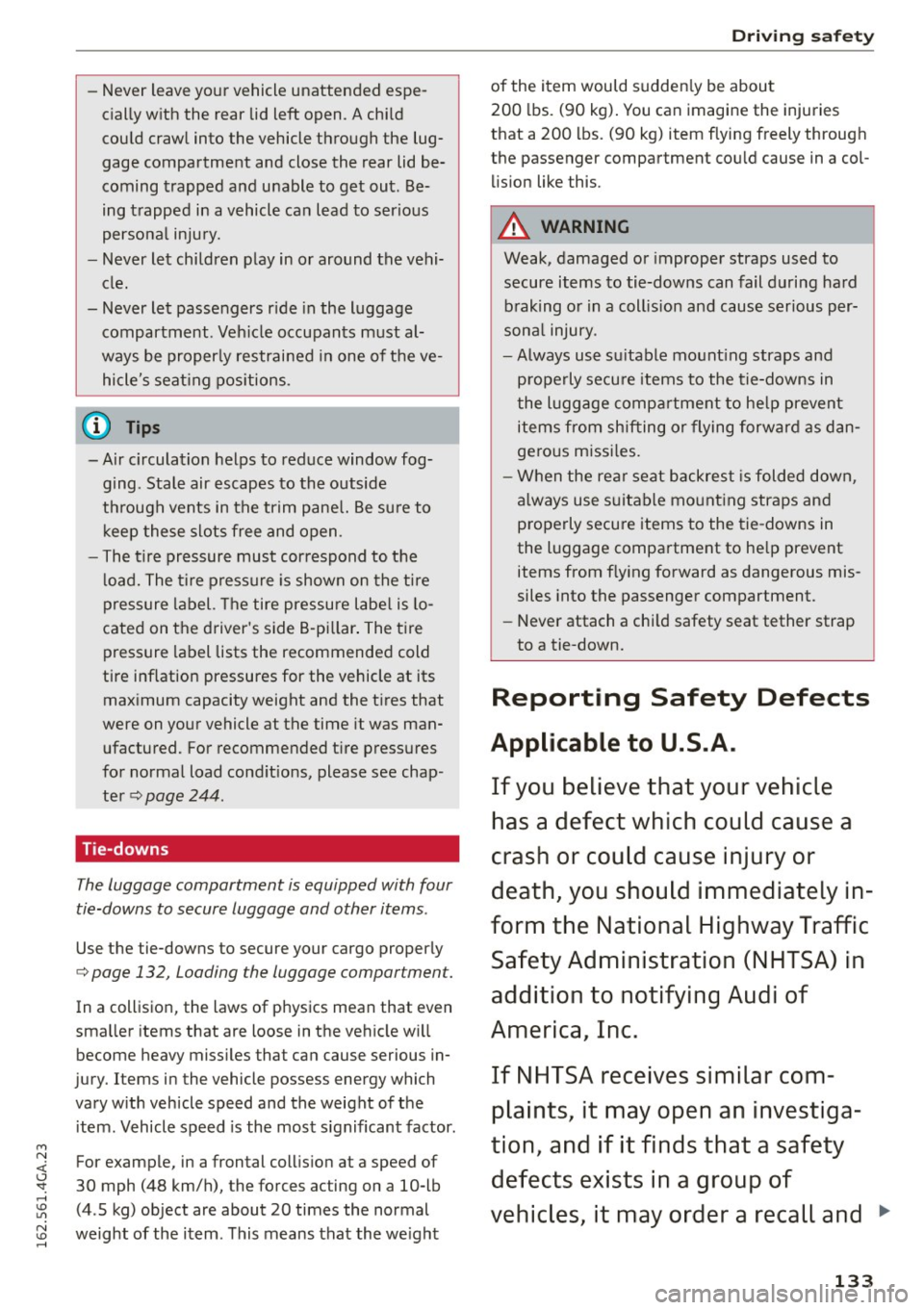
M N <( (.J
'SI: ,...., \!) 1.1"1
N \!) ,....,
-Never leave your vehicle unattended espe
cially w ith the rear lid left open. A chi ld
could crawl into the vehicle through the lug
gage compartment and close the rear lid be
coming trapped and unable to get out . Be
ing trapped in a vehicle can lead to serious
persona l inju ry.
- Never let children play in or around the vehi
cle.
- Never let passengers r ide in the luggage
compartment . Veh icle occupants m ust al
ways be properly restrained in one of the ve
hicle's seat ing pos itions.
-Air c irculation helps to reduce window fog
ging . Stale air escapes to the outside
th rough vents in the trim pane l. Be su re to
k eep the se slots free and open.
- The t ire pressure must correspond to the
l oad. The t ire pressure is shown o n the tire
pres sure label. T he tire pressure l abe l is lo
cated on the d river 's side B-pi llar . The t ire
pressure label lists the recommended cold
tire inflation pressures for the vehicle at its max imum capacity weight and the t ires that
were on your vehicle at the time it was man
ufactured. For recommended tire pressures
for normal load cond it ions, please see chap
te r
c:> page 244.
Tie-downs
The luggage compartment is equipped with four
tie-downs to secure luggage and other items.
Use the tie-downs to secure your cargo properly
c:> page 132, Loading the luggage compartment.
I n a collision, the laws of physics mean that even
sma ller items that are loose in the vehicle wi ll
become heavy miss iles that can cause serious in
jury . Items in the vehicle possess energy which
vary with vehicle speed and the weight of the
item . Vehicle speed is the most s ignificant factor .
For example, in a frontal collis ion at a speed of
30 mph (48 km/h), the forces acting on a 10-lb
(4 .5 kg) object are about 20 times the normal
weight of the item. This means that the we ight
Dr ivin g s afet y
of the item would sudden ly be about
200 lbs. (90 kg) . You can imagine the injuries
that a 200 lbs. (90 kg) item flying freely through
the passenger compartment co uld cause in a col
li sion like this.
A WARNING
=
Weak, damaged or imprope r straps used to
secure items to tie-downs can fail during ha rd
b raking o r in a coll is ion and cause serious per
sona l injury.
- Always use su itable mount ing straps and
p roperly secu re items to the tie-downs in
the l uggage compa rtment to he lp prevent
items from sh ifting or flying forw ard as dan
ge ro us m issi les.
- W hen the rea r seat backrest is folded down,
always use s uitable mo unt ing straps and
properly secu re items to the tie -downs in
the l uggage compa rtment to he lp prevent
items from f ly ing forward as dangerous mis
siles into the passenger compartment.
- Never attach a chi ld safety seat tether strap
to a tie-down.
-
Reporting Safety Defects
Applicable to U.S.A.
If you belie ve that your vehicle
has a def ect which could cause a
c rash or could cau se injur y or
de ath, you should imm ediately in
form the National High way Traffic
S afet y Adm ini stration (NHTSA) in
a ddition to notif yin g Audi of
America, In c.
If NHT SA re ceive s similar com
pl aint s, it may open an inv estig a
tion , and if it finds that a safety
defe cts exists in a group of
ve hicles, it may ord er a recall and .,
133
Page 136 of 294
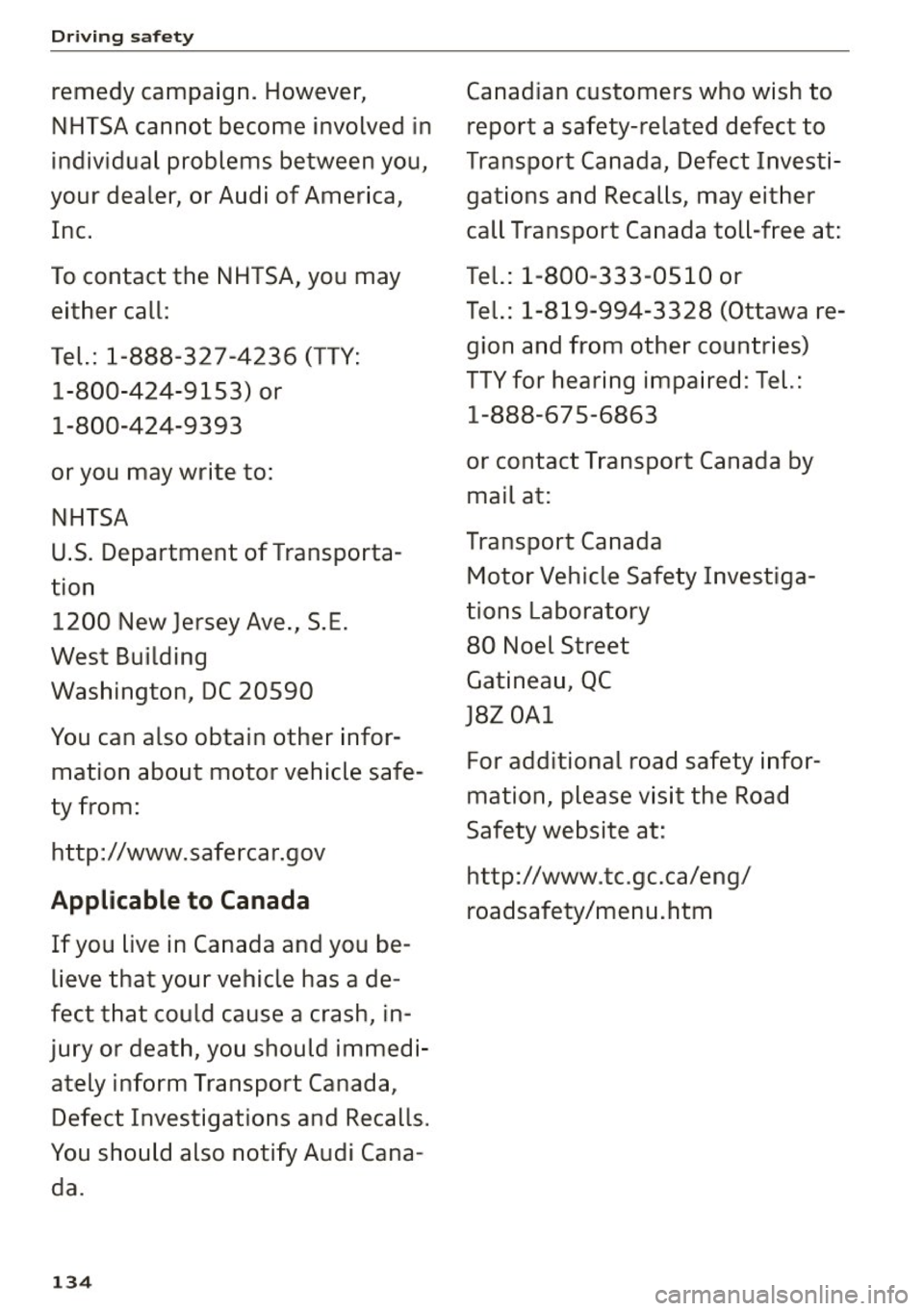
Driving safety
remedy campaign. However,
NHTSA cannot become involved in
individual problems between you,
your dealer, or Audi of America ,
Inc.
To contact the NHTSA, you may either call:
Tel.: 1-888-327-4236 (TTY:
1-800 -424 -9153) or
1-800-424-9 3 9 3
or you may write to: NHTSA
U .S. Department of Transporta
tion 1200 New Jersey Ave., S. E.
West Building
Washington, DC 20590
You can also obtain other infor mation about motor vehicle safe
ty from:
http://www.safercar.gov
Applicable to Canada
If you live in Canada and you believe that your vehicle has a de
fect that could cause a crash, in
jury or death, you should immedi
ately inform Transport Canada,
Defect Investigat ions and Recalls.
You should also notify Audi Cana
da.
1 34
Canadian customers who wish to
report a safety-related defect to
Transport Canada, Defect Investi
gations and Recalls, may either
call Transport Canada toll-free at :
Tel. : 1-800-333-0510 or
Tel.: 1-8 19-994-3328 (Ottawa re
gion and from other coun tries)
T TY for hearing impa ired : Tel.:
1-888-675-6863
or contact Transport Canada by mail at:
Transport Canada Motor Vehicle Safety Investiga
tions Laboratory
80 Noel Street
Gatineau, QC
J8Z OAl
For additional road safety infor
mation, please visit the Road
Safety website at:
http:/ /www .tc.gc.ca/eng/
roadsafety/menu.htm
Page 137 of 294
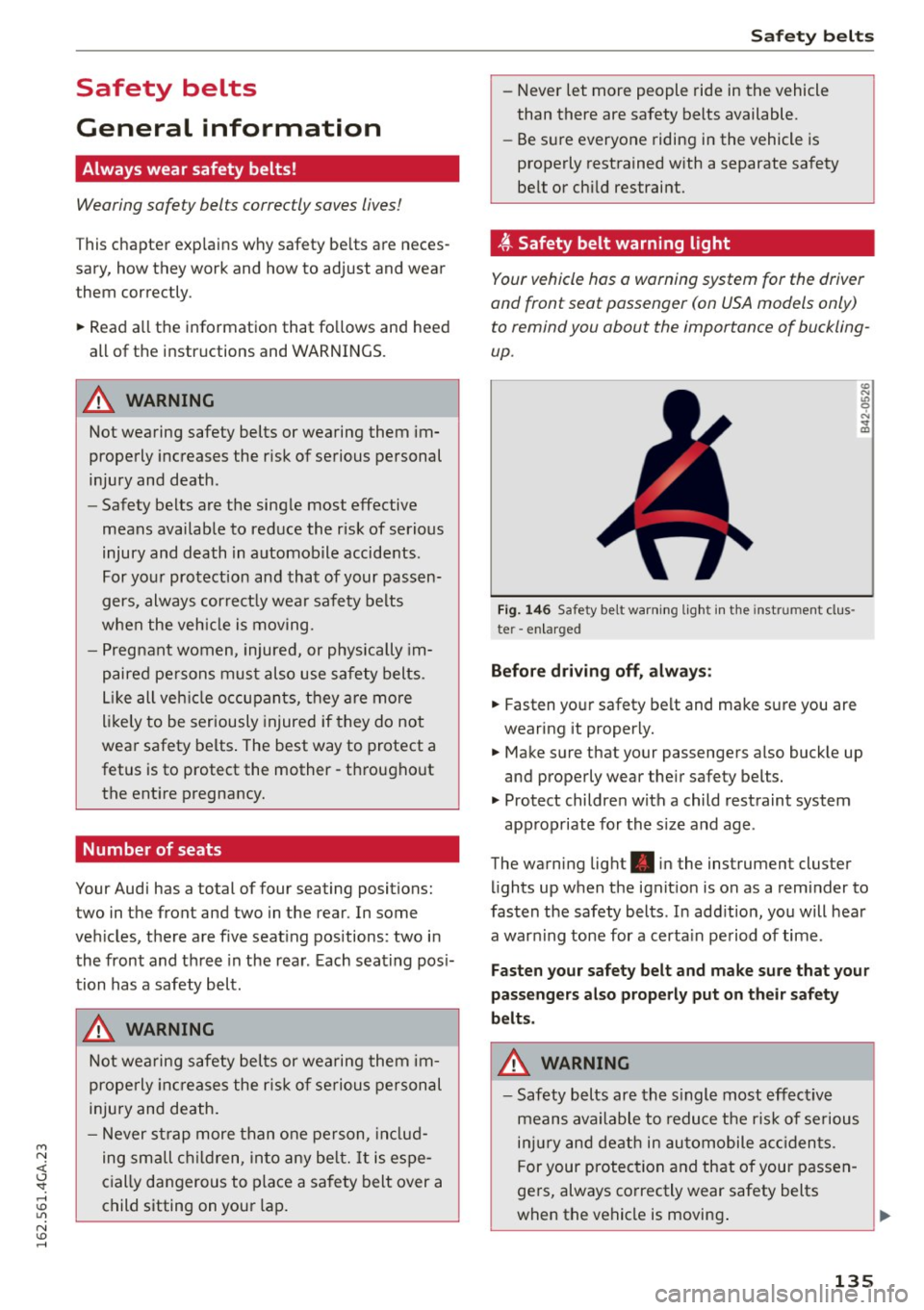
M N <( (.J
'SI: ,...., \!) 1.1"1
N \!) ,....,
Safety belts
General information
Always wear safety belts!
Wearing safety belts correctly saves lives!
This chapter exp lains why safety be lts are neces
sary, how they work and how to adjust and wear
them cor rectly.
~ Read a ll the information that fo llows and heed
all of the instructions and WARNINGS .
A WARNING
Not wearing safety belts or wearing them im
properly increases the risk of serious personal
injury and death.
- Safety belts are the sing le most effective
means availab le to reduce the risk of serious
injury and death in automobile accidents.
For yo ur protection and that of your passen
gers, always correct ly wear safety belts
when the veh icle is moving.
- Preg nant women, injured, or physically im
paired pe rsons must also use safety belts.
Lik e all ve hicle occupants, t hey are more
likely to be seriously injured if they do not
wea r safety belts . The best way to protect a
fetus is to protect the mother -througho ut
the entire pregnancy.
Number of seats
Your Audi has a total of four seating positions:
two in the front and two in the rear. In some
ve hicles, there are five seat ing positions: two in
the front and th ree in the rear . Each seat ing pos i
tion has a safety belt.
A WARNING
N ot wea ring safety bel ts or wearing them im
prope rly i ncrea ses the r is k of se rious person al
injury and death.
- Never st rap more than o ne pe rson, in cl ud
ing small c hildren, in to any bel t. It is espe
c ially dangerous to place a sa fety belt over a
child sitting on your lap.
Sa fety bel ts
- Never let more people ride in the vehicle
than there are safety belts available.
- Be s ure everyone riding in the vehicle is
properly restrained with a separate safety
belt or child restraint.
~ Safety belt warning light
Your vehicle has a warning system for the driver
and front seat passenger (on USA models only)
to remind you about the importance of buckling
up.
Fi g. 146 Safety belt warni ng light in the instr ument clus
te r -en larged
Befor e dr iv ing off , always :
~ Fasten yo ur safety belt and make su re you are
wearing it properly.
U) N
"' 0 ..:, .. m
~ Make sure that your passengers also buck le up
and properly wear their safety belts.
~ Protect childre n w ith a child restraint system
app rop riate for the s ize and age .
The warning lig ht . in the instrument cluster
li ghts up when the ignit ion is on as a reminder to
fasten the safety belts . In add ition, you will hear
a warn ing tone for a certa in pe riod of time .
Fasten your safety belt and make sure that your
passengers al so properly put on their safety
belts .
A WARNING
-
-Safety belts are the s ingle most effective
means ava ilable to reduce t he risk of se rious
inj ury and death in au tomobile acc iden ts.
F or your protec tion and that of your passen
ge rs, always correctly wear safety belts
when the vehicle is moving .
13 5
Page 138 of 294
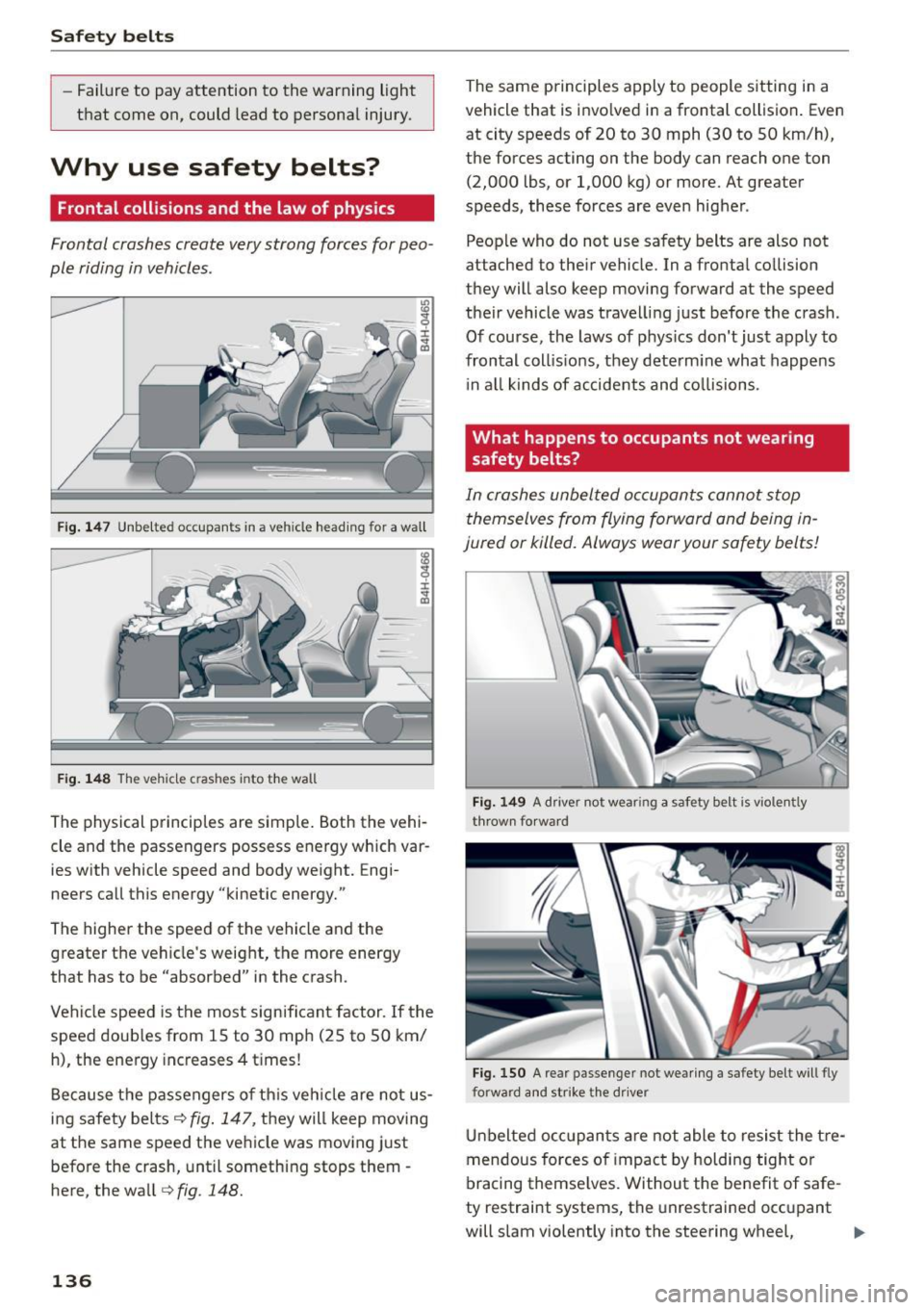
Safety belts
-Failure to pay attention to the warning light
that come on, could lead to personal injury.
Why use safety belts?
Frontal collisions and the law of physics
Frontal crashes create very strong forces for peo
ple riding in vehicles.
F ig. 147 Unbelted occupants in a vehicle heading for a wall
Fig . 148 The vehicle crashes into the wall
The physical principles are simple. Both the vehi
cle and the passengers possess energy which varies with vehicle speed and body weight. Engi
neers call this energy "kinetic energy."
The higher the speed of the vehicle and the
greater the vehicle's weight, the more energy
that has to be "absorbed" in the crash.
Vehicle speed is the most significant factor.
If the
speed doubles from 15 to 30 mph (25 to 50 km/
h), the energy increases 4 times!
Because the passengers of this vehicle are not us
ing safety belts¢
fig . 147, they will keep moving
at the same speed the vehicle was moving just
before the crash, until something stops them -
here, the wa ll
c> fig. 148.
136
The same principles apply to people sitting in a
vehicle that is invo lved in a frontal collision. Even
at city speeds of 20 to 30 mph (30 to 50 km/h),
the forces acting on the body can reach one ton
(2,000 lbs, or 1,000 kg) or more. At greater
speeds, these forces are even higher .
Peop le who do not use safety belts are also not
attached to their vehicle. In a fronta l co llision
they will also keep moving forward at the speed
their vehicle was travelling just before the crash.
Of course, the laws of phys ics don't just apply to
frontal coll is ions, they determine what happens
in all kinds of accidents and collisions.
What happens to occupants not wearing
safety belts?
In crashes unbelted occupants cannot stop
themselves from flying forward and being in
jured or killed. Always wear your safety belts!
Fig. 149 A driver not wearing a safety belt is violently
thrown forwar d
Fig. 150 A rear passenge r not wea ring a safety belt will fly
forward and strike the drive r
Unbelted occupa nts are not able to resist the t re
mendous forces of impact by holding tight or
bracing themselves. Without the benefit of safe
ty restraint systems, the unrestrained occupant
will slam violently into the steering wheel, .,.
Page 139 of 294

M N <( I.J "". rl I.O
"' N I.O rl
instrument panel, windshield, or whatever else is
in the way~
fig. 149. This impact with the vehi
cle interior has all the energy they had just before
the crash.
Never rely on airbags alone for protection. Even
when they deploy, airbags provide only additional
protection. Airbags are not supposed to deploy in
all kinds of accidents. Although your Audi is
equipped with airbags, all vehicle occupants, in
cluding the driver, must wear safety belts cor
rectly in order to minimize the risk of severe in
jury or death in a crash.
Remember too, that airbags will deploy only once
and that your safety belts are always there to of
fer protection in those accidents in which airbags
are not supposed to deploy or when they have al
ready deployed . Unbelted occupants can also be
thrown out of the vehicle where even more severe
or fatal injuries can occur.
It is also important for the rear passengers to
wear safety belts correctly . Unbelted passengers
in the rear seats endanger not only themselves
but also the driver and other passengers
¢ fig. 150. In a frontal collision they will be
thrown forward violently, where they can hit and
injure the driver and/or front seat passenger.
Safety belts protect
People think it's possible to use the hands to
brace the body in a minor collision. It's simply
not true!
Fig. 151 Driver is correc tly restra ined in a sudden braking
maneuve r
Safety belts used properly can make a big differ
ence. Safety belts help to keep passengers in
their seats, gradually reduce energy levels ap-
Safety belts
plied to the body in an accident, and help prevent
the uncontrolled movement that can cause seri
ous injuries . In addition, safety belts reduce the
danger of being thrown out of the vehicle.
Safety belts attach passengers to the car and give
them the benefit of being slowed down more
gently or "softly" through the "give" in the safety
belts, crush zones and other safety features engi
neered into today's vehicles. By "absorbing" the
kinetic energy over a longer period of time, the
safety belts make the forces on the body more
"tolerable" and less likely to cause injury.
Although these examples are based on a frontal collision, safety belts can also substantially re
duce the r isk of injury in other kinds of crashes.
So, whether you're on a long trip or just going to
the corner store, always buckle up and make sure
others do, too. Accident statist ics show that vehi
cle occupants properly wearing safety belts have
a lower risk of being injured and a much better
chance of surviving an accident. Properly using
safety belts also greatly increases the ability of
the supplemental airbags to do their job in a col lision. For this reason, wearing a safety belt is le
gally required in most countries including much
of the United States and Canada.
Although your Audi is equipped with airbags, you still have to wear the safety belts provided. Front
airbags, for example, are activated only in some
frontal coll isions. The front airbags are not acti
vated in all frontal coll is ions, in side and rear col
lisions, in roll overs or in cases where there is not
enough deceleration through impact to the front
of the vehicle. The same goes for the other airbag
systems in your Audi . So, always wear your safety
belt and make sure everybody in your vehicle is
properly restrained !
Important safety instructions about safety
belts
Safety belts must always be correctly positioned
across the strongest bones of your body.
.,. Always wear safety belts as illustrated and de
scribed in this chapter.
.,. Make sure that your safety belts are always
ready for use and are not damaged.
137
Page 140 of 294

Safety belts
_&. WARNING
Not wearing safety belts or wearing them im
properly increases the risk of serious personal
injury and death . Safety belts can work only
when used correctly .
- Always fasten your safety belts correctly be
fore driving off and make sure all passen
gers are correctly restrained.
- For maximum protection, safety belts must
always be positioned properly on the body .
- Never strap more than one person, includ
ing small children, into any belt .
- Never place a safety belt over a child sitting
on your lap .
- Always keep feet in the footwell in front of
the seat while the vehicle is being driven .
- Never let any person ride with their feet on
the instrument panel or sticking out the
window or on the seat .
- Never
remove a safety belt while the vehicle
is moving . Doing so will increase your risk of
being injured or killed .
- Never wear belts twisted .
- Never wear belts
over rigid or breakable ob-
jects in or on your clothing, such as eye
glasses, pens, keys, etc ., as these may cause
injury .
- Never allow safety belts to become dam
aged by being caught in door or seat hard
ware.
- Do not wear the shoulder part of the belt
under your arm or otherwise out of position .
- Several layers of heavy clothing may inter
fere with correct positioning of belts and re
duce the overall effectiveness of the system.
- Always keep belt buckles free of anything
that may prevent the buckle from latching
securely .
- Never use comfort clips or devices that cre
ate slack in the shoulder belt. However, spe
cial clips may be required for the proper use
of some child restraint systems.
- Torn or frayed safety belts can tear, and
damaged belt hardware can break in an acci
dent . Inspect belts regularly. If webbing,
bindings, buckles, or retractors are dam-
138
aged, have belts replaced by an authorized
Audi dealer or qualified workshop .
- Safety belts that have been worn and loaded
in an accident must be replaced with the
correct replacement safety belt by an au
thorized Audi dealer. Replacement may be
necessary
even if damage cannot be clearly
seen. Anchorages that were loaded must al
so be inspected.
- Never
remove, modify, disassemble, or try
to repair the safety belts yourself .
-Always keep the belts clean . Dirty belts may
not work properly and can impair the func
tion of the inertia reel¢
table on page 207.
Safety belts
Fastening safety belts
Safety first -everybody buckle up!
Fig. 152 Be lt buckl e and to ngue o n th e dri ver's se at
To provide maximum protection, s afety belts
must always be positioned correctly on the wea r
er's body.
... Adjust the front seat and head restra int proper
ly ¢
page 52, General informa tion.
... Make sure the seatback of the rear seat bench is
in an upright position and securely latched in
place before using the belt
q &_ .
.,. Hold the belt by the tongue and pull it evenly
across the chest and pelvis ¢&_ .
.,. Insert the tongue into the correct buckle of
your seat until you hear it latch securely
¢fig. 152.
... Pull on the belt to make sure that it is securely
latched in the buckle .
II>